人教新目标七年级英语下册第十单元教学设计
最新人教版新目标初中英语七年级下册《Unit 10 I’d like some noodles全单元教学设计》精品优秀整单元教案

最新精品人教版新目标初中英语七年级下册 Unit 10 I’d like some noodles优秀教学设计(全单元完整版)前言:该教学设计(教案)由多位一线国家特级教师根据最新课程标准的要求和教学对象的特点结合教材实际精心编辑而成。
实用性强。
高质量的教学设计(教案)是高效课堂的前提和保障。
(最新精品教学设计)Unit 10 I’d like some noodles一、教学目标1.学习would like的用法2.学会使用询问和表达面条的种类以及各种尺寸的大小。
二. 教学重点1)would like的用法。
2)句型的操练。
3) 名词的可数与不可数。
三.教学难点1) would like的用法。
2) 如何灵活的运用本单元的重点句型以及名词。
四、教学时间及安排:第1课时:Section A 1a-2b 第2课时:Section A 3-Section A 4第3课时:Section B la-Section B 2C 第4课时:Section B 3a--Self checkPeriod 1 (Section A 1a—2b)授课人:______ 授课班级: _____ 授课时间: 年___月___日___午第___节Language goalTo order food. To ask for and give personal information.To write their own ad for foods.Teaching proceduresStep 1 Presentation1、Look at the picture . Please answer the questions below1)Can you see three bowls? 2)What are in them?3)Do you like noodles? 4)Can you find the differences among the three bowl s of noodles?5) What size bowl of noodles would you like -----small, medium, or large?6)Look at the sign ____Special 1,Special2,Special3.And understand their mean ings.2、Look at the numbered list of ingredients .Read and repeat.3、Ask students to match each word with the foods.4、Check the answers.Step 2 Listening1、Look at the three bowls of noodles. Ask: What ingredients are in these noo dles?2、Play the recording the first time .Students only listen.3、Play the recording a second time.4、Correct the answers.Step3 Practice1、Read the conversation in the picture in 1a.2、Ask students to work in pairs. One person is the waiter, the other one is the customer.3、Perform the conversation in front of the classroom.Step4 Listening1、Look at the food in the picture in 2a and name each one.2、Read the numbered list of words.3、Say, you will hear a conversation. The people will talk about some of the foods, but they will not talk about others. Please check the names of the food yo u hear below.4、Play the recording a second time.5、Correct the answers.Step5 Listening1、Read the conversation in 2b. Point to the blank lines .Say ,listen again a nd fill in the blanks now.2、Check the answers.Step6 Practice1、Read the conversation in 2c yourselves.2、Work in pairs. Each student can be both the waiter and the customer. Say w hat you really like with your noodles.Step7 HomeworkCopy the new words. Do Exercises 1 and 2.教学后记:Period 2 (Section A 3-Section A 4)授课人:______ 授课班级: _____ 授课时间: 年___月___日___午第___节aimsTo order food. To ask for and give personal information.To write their own ad for foods.Language goalI’d like some noodles.What kind of noodles would you/he/she/they like?I’d/He’d/She’d/They’d like beef noodles.What size bowl of noodles would you/he/she/they like?Teaching proceduresStep One: Revision1 Revise the food words.2 Revise: What kind of noodles would you like? I’d like …。
人教版新目标七年级英语下册Unit10教案.doc
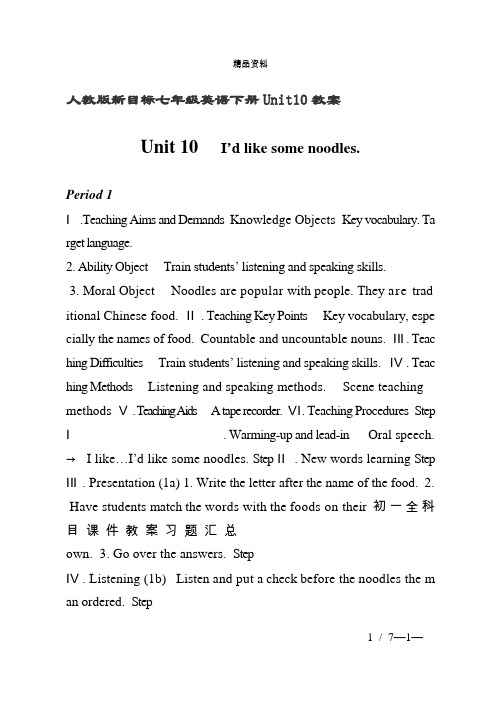
人教版新目标七年级英语下册Unit10教案Unit 10 I’d like some noodles.Period 1Ⅰ.Teaching Aims and Demands Knowledge Objects Key vocabulary. Ta rget language.2. Ability Object Train students’ listening and speaking skills.3. Moral Object Noodles are popular with people. They are trad itional Chinese food. Ⅱ. Teaching Key Points Key vocabulary, espe cially the names of food. Countable and uncountable nouns. Ⅲ. Teac hing Difficulties Train students’ listening and speaking skills. Ⅳ. Teac hing Methods Listening and speaking methods. Scene teaching methods Ⅴ. Teaching Aids A tape recorder. Ⅵ. Teaching Procedures Step Ⅰ. Warming-up and lead-in Oral speech.→ I like…I’d like some noodles. StepⅡ. New words learning Step Ⅲ. Presentation (1a) 1. Write the letter after the name of the food. 2. Have students match the words with the foods on their 初一全科目课件教案习题汇总own. 3. Go over the answers. StepⅣ. Listening (1b) Listen and put a check before the noodles the m an ordered. StepⅤ. Pairwork(1c) Ask students to practice similar conversation s in pairs. Students take turns to be the customer and the noodles ma ker. StepⅥ. Summary and homework Remember the words and practice the target language.Period 2Ⅰ.Teaching Aims and Demands 1. Knowledge Objects Target language Ability Object Train students’ listening and speaking skills. Train stude nts’ communicative competence. Moral Object Noodles are popular with people. They are traditional Chinese food. Ⅱ. Teaching Key Poi nts T h e t a r g e t l a n g u a g e u s e d f o r a s k f o r a n d g i v e p e r s o n a l information. Order food. Ⅲ. Teaching Difficulties Train students’ listening and speaking skills. Train students’ commu nicative competence. Ⅳ. Teaching Methods Listening and speaking methods. Scene teaching methods Ⅴ. Teaching Aids A tape recorder Ⅵ. Teaching Procedures Step Ⅰ. Warming-up and revision Oral speech and free talk. Step Ⅱ. Listening (2a 2b) 1. Y o u’r e t o listen and check the names of the foods you hear on the tape. 2. Play the recording twice. Then che ck the answers. 3. P lay th e s ame record ing ag ain. Lis t en carefully and fill in the blanks. StepⅢ. Pairwork (2c,2d) 1. Work with a partner. One is a customer and t he other is a waiter. 2. Invite several pairs of students to act out the ir conversations in front of the class. 3.Have some students role-p lay the conversations in pairs,then explain it to the class. StepⅣ. Grammar Focus G u i d e t h e s t u d e n t s t o m a k e s o m e s e n t e n c e s w i t h I’d,H e’d and They’d. StepⅤ. Conversation practice (3a ,3b) 1. You are to match each question wi th an answer. 2. Get students to do the task in pairs. 3. Put students i nto pairs. One is working in a noodles h o u s e.T h e o t h e r i s t h e c u s t o m e r.G e t t h e p a i r s t o s t a r t t h e activity. Ste pⅥ. Summary and homework 1. S u m m a r y t h e t a r g e t l a n g u a g e w e’v e l e a r n e d i n t h i s class. 2. Reread the conversa tion in 3a. try to recite it. 3. Write down the conversation in 3c.Period 3Ⅰ. T eaching Aims and Demands Knowledge Objects Key vocabulary. T ar get language. 2. Ability Object Train students’ listening and speaking skill s. Train students’ communicative competence. 3. Moral Object Every one should choose foods which are good for h is health. Ⅱ. Teachi ng Key Points Learn how to ask for and give personal information an d write down the information. Ⅲ. Teaching Difficulties Learn howto ask for and give personal information and write down the i nformation. Ⅳ. Teaching Methods Practicing methods. Scene teach ing methods Ⅴ. T eaching A ids A tape recorder Ⅵ. Teaching Procedures StepⅠ.Warming-up and lead-in Oral speech. Describe one’s preferenc es. StepⅡ. New words learning. Porridge onion fish pancake Step Ⅲ. Presentation (1a 1b) 1. Match the words with the pictures. Write the letter of the food on the blank line before its name.2. Circle the things you like in the picture. And make an “×” nex t to the things you don’t like. StepⅣ. Listening (1c,1d) 1. Listen carefully and circle in activity 1a th e words that you hear on the tape. 2. Play the same recording again. W rite down the customer’s address, telephone number and what he or ders. 3.Check the answers. StepⅤ. Pairwork (2a) 1. Put students into pairs. Ask questions abo ut what they door eat on their birthdays. 2. Invite more advanced students t o demonstrate how to do the activity. StepⅥ.Summary and homework Remember the key words and target la nguage.Period 4Ⅰ. T eaching Aims and Demands Knowledge Objects Learn to read and write an ad for House of Dumplings. 2. Ability Object Train student s’ reading and writing skills. Train students’ integrating skills. 3. Moral Object Keep healthy. Ⅱ. Teaching Key Points Learn how to order fo od. Learn to write an ad for House of Dumplings. Ⅲ. T eaching Diffic ulties Learn how to order food. Learn to write an ad for House of D umplings. Ⅳ. Teaching Methods reading and writing methods. Practi cing methods Ⅴ. T eaching A ids A tape recorder Ⅵ. Teaching Procedure s Step I. Warming-up and revision Oral speech and dictation. Step II.R eading and answering(2b,2c) Do 2b:Ask students to read the article and complete the c h a r t,t h e n c h e c k t h e a n s w e r s.E x p l a i n t h e k e y p o i n t s t o the class. D o2c:H a v e s t u d e n t s r e a d t h e a r t i c l e a g a i n a n d a n s w e r t h e questions,then check the answers. Step III. Reading (3a) Fill in the blank lines, usi ng words from the box. Get students to complete the paragraph on t heir own. Step IV. Writing (3b,3c) 1.W r i t e y o u r o w n a d.P l e a s e u s e t h e a d i n a c t i v i t y3a a s a model. 2. Us e the sample version in activity 1c to demonstrate how to order a meal. 3.Have some students to read their ads to the class. Step V. P airwork Let students work in pairs to order meal. Students p ractice both roles. Step VI. Summary and homework Order food.Period 5Ⅰ. T eaching Aims and Demands Knowledge Objects R e v i e w t h e n a me s o f f o o d s a n d d r i n k s,t h e t a rg e t l a n g u a g e used to order food, ask for and give personal information and design an ad.2. Ability Object Train students’ communicative competence.3. Moral Object Noodles, a kind of fast food, helps save a lot of time. And it ’s delicious and rich in nutrient, thank the inventor. Ask your family members or classmates what they’d like to eat. In this way, you will understand each other better. Ⅱ. Teaching Key Points Review all the key words and order food. Review to ask for and give person al information. Ⅲ. Teaching Difficulties Order food, design an ad fo r House of Dumplings. Ⅳ. Teaching Methods Practicing methods. Ⅴ. T eaching A ids Ⅵ. Teaching Procedures StepⅠ.W arming-up Step Ⅱ. Review the key vocabulary Give students several minutes to me morize the key vocabulary. Large, medium, noodles, beef, mutton, chic ken, cabbage, potatoes, tomatoes, dumplings, soup, green tea, orang e juice. StepⅢ. Self Checks1, 2 ,3 D o S e l f C h e c k1.A s k s t u d e n t s t o c h e c k a l l t h e w o r d s t h e y know. Write five new word s in their V ocab-builder. Do Self Check2. Ask students to complete the task,then h a v e s o me s t u d en ts r e a d th e 3co n v e r s at io n s t o t h e c l as s i n pairs. D o S e lf C h e c k3. A s k s t u d e n t s t o w r i t e a c o n v e r s a t i o n w i t h the help of the clues in pairs,t hen have some pairs read their conversations to the class. Step Ⅳ. Review the target language Make a conversation use the target la nguage. What kind of noodles would you like? →I’d like beef noodles. What size bowl of noodles would you like? →I’d like a small/medium/large bowl of noodles. What’s your address? →My address is …. Get several pairs of students to act out their conv ersations. StepⅤ.Summary and homework Summary the language we’ve learned in this unit. Finish 3c as your homework.。
人教版新目标七年级英语下册 Unit 10教学设计(5课时)

人教版新目标七年级英语下册 Unit 10教学设计(5课时)一. 教材分析人教版新目标七年级英语下册Unit 10主要讲述了关于日常生活中的不同职业和人们的工作内容。
通过本单元的学习,学生能够掌握与职业相关的词汇和表达方式,听懂、会说、会读关于不同职业的对话,并能够运用所学知识进行简单的交流。
教材内容丰富,贴近学生生活,有利于激发学生的学习兴趣,提高学生的英语交际能力。
二. 学情分析七年级的学生已经掌握了基本的英语语法和词汇知识,具备一定的听、说、读、写能力。
但部分学生对英语学习仍存在恐惧心理,缺乏自信心。
针对这一情况,教师应关注学生的个体差异,鼓励学生积极参与课堂活动,增强学生的自信心。
此外,学生对日常生活中的不同职业有一定的了解,但可能对某些职业的具体工作内容不够清楚,教师应在教学中予以补充和拓展。
三. 教学目标1.知识目标:学生能够掌握与职业相关的词汇和表达方式,了解不同职业的工作内容。
2.能力目标:学生能够听懂、会说、会读关于不同职业的对话,并能够运用所学知识进行简单的交流。
3.情感目标:培养学生对不同职业的尊重和理解,拓宽视野,树立正确的职业观念。
四. 教学重难点1.重点:学生能够掌握与职业相关的词汇和表达方式,听懂、会说、会读关于不同职业的对话。
2.难点:学生能够运用所学知识进行简单的交流,并能够正确运用职业词汇进行表达。
五. 教学方法1.情境教学法:通过设定各种职业情境,让学生在实际语境中学习和运用职业词汇和表达方式。
2.交际教学法:引导学生参与角色扮演、小组讨论等互动活动,提高学生的英语交际能力。
3.任务型教学法:布置相关职业的调查任务,让学生在完成任务的过程中,巩固和拓展所学知识。
六. 教学准备1.教学课件:制作含有不同职业图片、词汇和对话的课件,以便在课堂上进行展示和教学。
2.教学素材:准备与职业相关的图片、视频等素材,丰富教学内容,提高学生的学习兴趣。
3.调查问卷:设计一份关于学生家长职业的调查问卷,以便在课堂上进行调查和交流。
人教新目标七年级英语下册第十单元教学设计
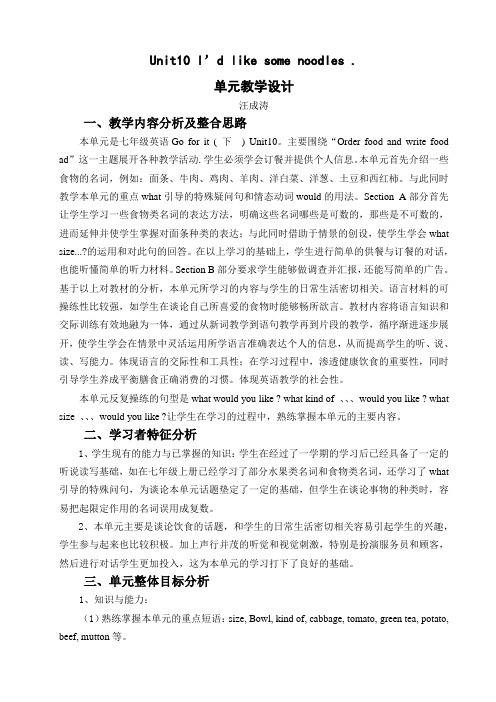
Unit10 I’d like some noodles .单元教学设计汪成涛一、教学内容分析及整合思路本单元是七年级英语Go for it ( 下) Unit10。
主要围绕“Order food and write food ad”这一主题展开各种教学活动.学生必须学会订餐并提供个人信息。
本单元首先介绍一些食物的名词,例如:面条、牛肉、鸡肉、羊肉、洋白菜、洋葱、土豆和西红柿。
与此同时教学本单元的重点what引导的特殊疑问句和情态动词would的用法。
Section A部分首先让学生学习一些食物类名词的表达方法,明确这些名词哪些是可数的,那些是不可数的,进而延伸并使学生掌握对面条种类的表达;与此同时借助于情景的创设,使学生学会what size...?的运用和对此句的回答。
在以上学习的基础上,学生进行简单的供餐与订餐的对话,也能听懂简单的听力材料。
Section B部分要求学生能够做调查并汇报,还能写简单的广告。
基于以上对教材的分析,本单元所学习的内容与学生的日常生活密切相关。
语言材料的可操练性比较强,如学生在谈论自己所喜爱的食物时能够畅所欲言。
教材内容将语言知识和交际训练有效地融为一体,通过从新词教学到语句教学再到片段的教学,循序渐进逐步展开,使学生学会在情景中灵活运用所学语言准确表达个人的信息,从而提高学生的听、说、读、写能力。
体现语言的交际性和工具性;在学习过程中,渗透健康饮食的重要性,同时引导学生养成平衡膳食正确消费的习惯。
体现英语教学的社会性。
本单元反复操练的句型是what would you like ? what kind of 、、、would you like ? what size 、、、would you like ?让学生在学习的过程中,熟练掌握本单元的主要内容。
二、学习者特征分析1、学生现有的能力与已掌握的知识:学生在经过了一学期的学习后已经具备了一定的听说读写基础,如在七年级上册已经学习了部分水果类名词和食物类名词,还学习了what 引导的特殊问句,为谈论本单元话题垫定了一定的基础,但学生在谈论事物的种类时,容易把起限定作用的名词误用成复数。
2020年春人教新目标英语七年级下册unit10全单元教案

2020年春人教新目标英语七年级下册学科英语年级七年级审批周次第周份数2第四课时第五课时翻译官1. 想要,喜欢_______2. 牛肉面_________ 3 . 卷心菜__________ 4. 鸡肉_______5. 羊肉_____6. 胡萝卜_________7. 土豆(复数) _______8. 西红柿(复数) ___________9. special __________10. 我还没想好。
_______________Fill in the blanks1. Li Lei likes eating _________ (羊肉) and ________(萝卜).2. I eat a lot of ___________ (西红柿) and _____________(洋白菜).3. Do you like ________ (土豆) and _______ (牛肉) noodles?4. What _______ (种类) of noodles _______ (想要) you like?5. Would you like _______ (一些) apples?.汉译英1. 我想要一台电脑。
2. 他想要带有牛肉和西红柿的面条。
3. 他们不想要那些鸡蛋。
4. 她想要带有羊肉和卷心菜的面条吗?5. 李雷想去看电影。
6. 南希和王莉想去买东西。
7. 超市里有各种各样的钢笔。
8. 那只小老虎有几分可爱。
9.我的愿望将会实现。
My dream will .10.过生日的人必须许个愿,吹灭蜡烛。
The birthday person must and the candles.11.在英国,人们有时放个糖果在生日蛋糕里In the UK,people sometimes a candy a birthday cake.12.在中国,长面条是长寿的象征。
In China,long noodles a long life.13.他们把好运带给过生日的人。
初中英语人教版七年级下册unit 10 Section A 1a-2c教学设计
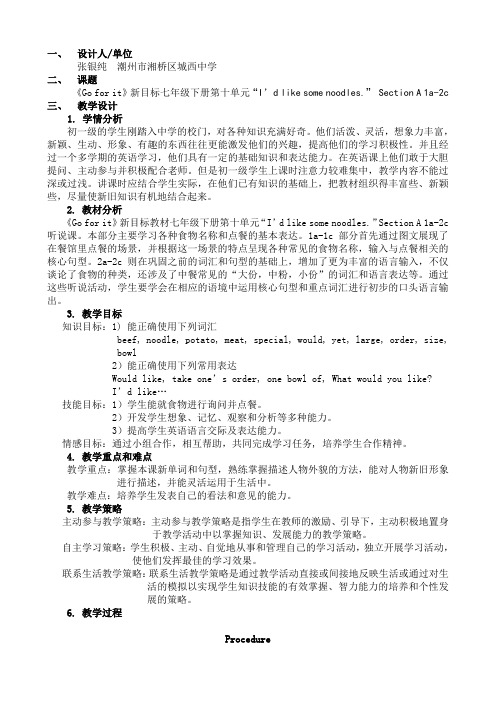
一、设计人/单位张银纯潮州市湘桥区城西中学二、课题《Go for it》新目标七年级下册第十单元“I’d like some noodles.” Section A 1a-2c三、教学设计1. 学情分析初一级的学生刚踏入中学的校门,对各种知识充满好奇。
他们活泼、灵活,想象力丰富,新颖、生动、形象、有趣的东西往往更能激发他们的兴趣,提高他们的学习积极性。
并且经过一个多学期的英语学习,他们具有一定的基础知识和表达能力。
在英语课上他们敢于大胆提问、主动参与并积极配合老师。
但是初一级学生上课时注意力较难集中,教学内容不能过深或过浅。
讲课时应结合学生实际,在他们已有知识的基础上,把教材组织得丰富些、新颖些,尽量使新旧知识有机地结合起来。
2.教材分析《Go for it》新目标教材七年级下册第十单元“I’d like some noodles.”Section A 1a-2c 听说课。
本部分主要学习各种食物名称和点餐的基本表达。
1a-1c部分首先通过图文展现了在餐馆里点餐的场景,并根据这一场景的特点呈现各种常见的食物名称,输入与点餐相关的核心句型。
2a-2c则在巩固之前的词汇和句型的基础上,增加了更为丰富的语言输入,不仅谈论了食物的种类,还涉及了中餐常见的“大份,中粉,小份”的词汇和语言表达等。
通过这些听说活动,学生要学会在相应的语境中运用核心句型和重点词汇进行初步的口头语言输出。
3.教学目标知识目标:1) 能正确使用下列词汇beef, noodle, potato, meat, special, would, yet, large, order, size, bowl2)能正确使用下列常用表达Would like, take one’s order, one bowl of, What would you like?I’d like…技能目标:1)学生能就食物进行询问并点餐。
2)开发学生想象、记忆、观察和分析等多种能力。
人教版新目标七年级英语下册Unit10教案.doc
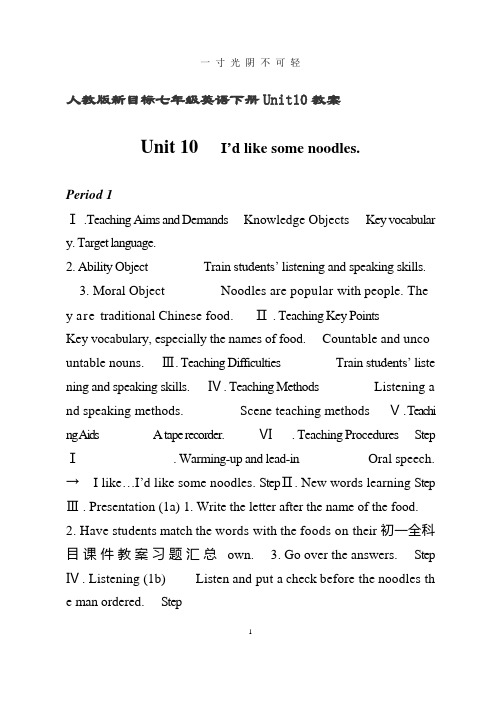
人教版新目标七年级英语下册Unit10教案Unit 10 I’d like some noodles.Period 1Ⅰ.Teaching Aims and Demands Knowledge Objects Key vocabular y. Target language.2. Ability Object Train students’ listening and speaking skills.3. Moral Object Noodles are popular with people. The y are traditional Chinese food. Ⅱ. Teaching Key PointsKey vocabulary, especially the names of food. Countable and unco untable nouns. Ⅲ. Teaching Difficulties Train students’ liste ning and speaking skills. Ⅳ. Teaching Methods Listening a nd speaking methods. Scene teaching methods Ⅴ. Teachi ng Aids A tape recorder. Ⅵ. Teaching Procedures Step Ⅰ. Warming-up and lead-in Oral speech.→I like…I’d like some noodles. StepⅡ. New words learning Step Ⅲ. Presentation (1a) 1. Write the letter after the name of the food.2. Have students match the words with the foods on their 初一全科目课件教案习题汇总own.3. Go over the answers. Step Ⅳ. Listening (1b) Listen and put a check before the noodles th e man ordered. Step1Ⅴ. Pairwork(1c) Ask students to practice similar conversations in pairs. Students take turns to be the customer and the noodles maker. StepⅥ. Summary and homework Remember the words and practice t he target language.Period 2Ⅰ.Teaching Aims and Demands 1. Knowledge Objects Target lang uage Ability Object Train students’ listening and speaking skills. Tr ain students’ communicative competence. Moral Object Noodles a re popular with people. They are traditional Chinese food. Ⅱ. Tea ching Key Points T h e t a r g e t l a n g u a g e u s e d f o r a s k f o r a n d g i v e p e r s o n a l information. Order fo od. Ⅲ. Teaching Difficulties Train students’ listening and sp eaking skills. Train students’ communicative competence. Ⅳ. Teaching Methods Listening and speaking methods. Scene teaching methods Ⅴ. Teaching Aids A tape recorder Ⅵ. Teaching Procedures Step Ⅰ. Warming-up and revision Oral speech and free talk. Step Ⅱ. Listening (2a 2b) 1. Y o u’r e t o listen and check the nam es of the foods you hear on the tape. 2. Play the recordin g twice. Then check the answers. 3. Play th e sa me2reco rdin g ag ain. Lis ten carefu lly an d fill in the blanks. StepⅢ. Pairwork (2c,2d) 1. Work with a partner. One is a cust omer and the other is a waiter. 2. Invite several pairs of stu dents to act out their conversations in front of the class. 3. Have some students role-play the conversations in pairs,then explain it to the class. StepⅣ. Grammar Focus G u i d e t h e s t u d e n t s t o m a k e s o m e s e n t e n c e s w i t h I’d,H e’d and They’d.StepⅤ. Conversation practice (3a ,3b) 1. You are to match each question with an answer. 2. Get students to do the task in pairs. 3. Put stud ents into pairs. One is working in a noodles h o u s e.T h e o t h e r i s t h e c u s t o m e r.G e t t h e p a i r s t o s t a r t t h e activ ity. StepⅥ. Summary and homework 1. S u m m a r y t h e t a r g e t l a n g u a g e w e’v e l e a r n e d i n t h i s class. 2. Re read the conversation in 3a. try to recite it. 3. Write dow n the conversation in 3c.Period 3Ⅰ. T eaching Aims and Demands Knowledge Objects Key vocabulary . T arget language. 2. Ability Object Train students’ listening and speaki3ng skills. Train students’ communicative competence. 3. Moral Ob ject Everyone should choose foods which are good for h is healt h. Ⅱ. Teaching Key Points Learn how to ask for and give persona l information and write down the information. Ⅲ. Teaching Difficulti es Learn how to ask for and give personal informati on and write down the information. Ⅳ. Teaching Methods Practicing methods. Scene teaching methods Ⅴ. T eaching A idsA tape recorder Ⅵ. Teaching Procedures Step Ⅰ.Warming-up and lead-in Oral speech. Describe one’s preferences. StepⅡ. New words learning. Porridge onion fish pa ncake StepⅢ. Presentation (1a 1b) 1. Match the words with the picture s. Write the letter of the food on the blank line before its name.2. Circle the things you like in the picture. And make a n “×” next to the things you don’t like. StepⅣ. Listening (1c,1d) 1. Listen carefully and circle in activity 1a t he words that you hear on the tape. 2. Play the same recording ag ain. W rite down the customer’s address, telephone number and what h e orders. 3.Check the answers. StepⅤ. Pairwork (2a) 1. Put students into pairs. Ask questions ab out what they do4or eat on their birthdays. 2. Invite more advanced students t o demonstrate how to do the activity. StepⅥ.Summary and homework Remember the key words and target la nguage.Period 4Ⅰ. T eaching Aims and Demands Knowledge Objects Learn to read and write an ad for House of Dumplings. 2. Ability Object T rain students’ reading and writing skills. Train students’ integratin g skills. 3. Moral Object Keep healthy. Ⅱ. Teaching Key Po ints Learn how to order food. Learn to write an ad for House of Dumplings. Ⅲ. T eaching Difficulties Learn how to order food. Learn to write an ad for House of Dumplings. Ⅳ. Teaching Methods reading and writing methods. Practicing methods Ⅴ. T eaching A id s A tape recorder Ⅵ. Teaching Procedures Step I. Warming -up and revision Oral speech and dictation. Step II.Reading and answe ring(2b,2c) Do 2b:Ask students to read the article and complete the c h a r t,t h e n c h e c k t h e a n s w e r s.E x p l a i n t h e k e y p o i n t s t o the class. D o2c:H a v e s t u d e n t s r e a d t h e a r t i c l e a g a i n a n d a n s w e r t h e questions,then check the answers.Step III. Reading (3a) Fill in the blank lines, using words from t he box. Get students to complete the paragraph on their own. St5ep IV. Writing (3b,3c) 1.W r i t e y o u r o w n a d.P l e a s e u s e t h e a d i n a c t i v i t y3a a s a model. 2. Use the sam ple version in activity 1c to demonstrate how to order a meal. 3. Have some students to read their ads to the class. Step V. Pairwork Let students work in pairs to order meal. Students practi ce both roles. Step VI. Summary and homeworkOrder food.Period 5Ⅰ. T eaching Aims and Demands Knowledge Objects R e v i e w t h e n a me s o f f o o d s a n d d r i n k s,t h e t a rg e t l a n g u a g e use d to order food, ask for and give personal information and design an ad. 2. Ability Object Train students’ communicative competen ce. 3. Moral Object Noodles, a kind of fast food, helps save a lot of time. And it’s delicious and rich in nutrient, thank the inventor.Ask your family members or classmates what they’d l ike to eat. In this way, you will understand each other better. Ⅱ. Teac hing Key Points Review all the key words and order food.Review to ask for and give personal information. Ⅲ. Tea ching Difficulties Order food, design an ad for House of Du mplings. Ⅳ. Teaching Methods Practicing methods. Ⅴ. T eaching A ids Ⅵ. Teaching Procedures StepⅠ.W arming-up Step6Ⅱ. Review the key vocabulary Give students several minutes to memorize the key vocabulary. Large, medium, noodles, beef, mutton, chicken, cabbage, potatoes, tomatoes, dumplings, soup, green tea, o range juice. StepⅢ. Self Checks1, 2 ,3 D o S e l f C h e c k1.A s k s t u d e n t s t o c h e c k a l l t h e w o r d s t h e y know. Write five new wor ds in their V ocab-builder. Do Self Check2. Ask students to complet e the task,then h av e s o me s t u d en t s re a d t h e3 c o n v e rs a ti o n s t o th e c la s s i n pairs. D o S e l f C h e c k3. A s k s t u d e n t s t o w r i t e a c o n v e r s a t i o n w i t h the help of the clues in pai rs,then have some pairs read their conversations to the class. Ste pⅣ. Review the target language Make a conversation use the target language. What kind of noodles would you like? →I’d like beef noodles. What size bowl of noodles would you like?→I’d like a small/medium/large bowl of noodles. What’s your address ? →My address is ….Get several pairs of students to act out their con versations. StepⅤ.Summary and homework Summary the language we’ve lear ned in this unit.Finish 3c as your homework.78。
七年级英语下册Unit10I’dlikesomenoodles教案(新版)人教新目标版
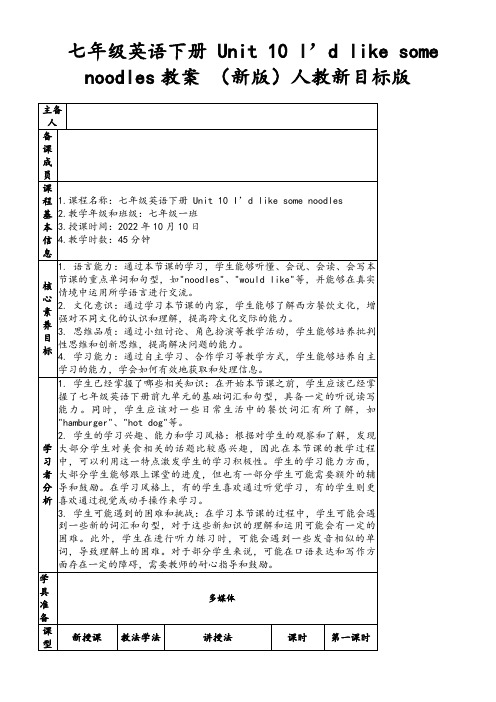
重点题型整理
(1)题型一:单词拼写
题目:请根据单词的音标和中文意思,写出正确的单词。
答案:hamburger(汉堡包)、hot dog(热狗)、sandwich(三明治)、pizza(披萨)、noodles(面条)
- 在线工具:利用在线工具进行词汇游戏和听力练习,增加学习的趣味性和互动性。
- 实物和图片:准备相关的实物和图片,让学生更直观地理解和记忆新词汇。
教学实施过程
1. 课前自主探索
教师活动:
- 发布预习任务:通过在线平台或班级微信群,发布预习资料(如PPT、视频、文档等),明确预习目标和要求。
- 设计预习问题:围绕Unit 10 "I’d like some noodles"课题,设计一系列具有启发性和探究性的问题,引导学生自主思考。
七年级英语下册 Unit 10 I’d like some noodles教案 (新版)人教新目标版
主备人
备课成员
课程基本信息
1.课程名称:七年级英语下册 Unit 10 I’d like some noodles
2.教学年级和班级:七年级一班
3.授课时间:2022年10月10日
4.教学时数:45分钟
核心素养目标
1. 语言能力:通过本节课的学习,学生能够听懂、会说、会读、会写本节课的重点单词和句型,如"noodles"、"would like"等,并能够在真实情境中运用所学语言进行交流。
2. 文化意识:通过学习本节课的内容,学生能够了解西方餐饮文化,增强对不同文化的认识和理解,提高跨文化交际的能力。
新目标七年级英语下册第10单元教案.doc
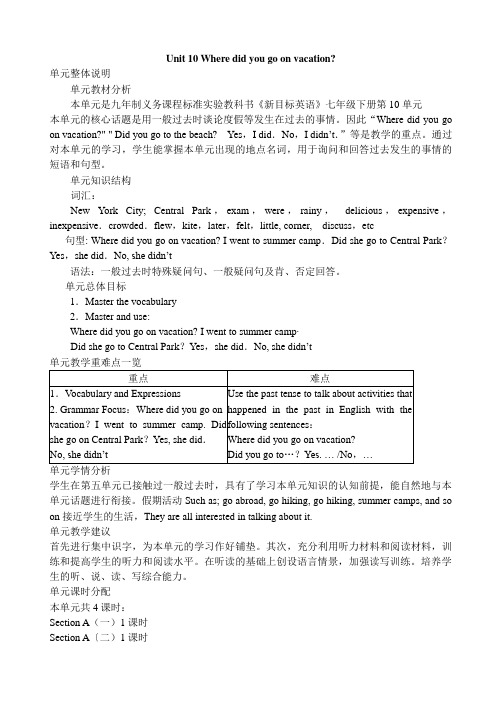
Unit 10 Where did you go on vacation?单元整体说明 单元教材分析本单元是九年制义务课程标准实验教科书《新目标英语》七年级下册第10单元本单元的核心话题是用一般过去时谈论度假等发生在过去的事情。
因此“Where did you go on vacation?" " Did you go to the beach? Y es ,I did .No ,I didn ’t .”等是教学的重点。
通过对本单元的学习,学生能掌握本单元出现的地点名词,用于询问和回答过去发生的事情的短语和句型。
单元知识结构词汇:New Y ork City; Central Park ,exam ,were ,rainy , delicious ,expensive ,inexpensive .crowded .flew ,kite ,later ,felt ,little, corner, discuss ,etc句型: Where did you go on vacation? I went to summer camp .Did she go to Central Park ?Y es ,she did .No, she didn’t语法:一般过去时特殊疑问句、一般疑问句及肯、否定回答。
单元总体目标1.Master the vocabulary 2.Master and use:Where did you go on vacation? I went to summer camp·Did she go to Central Park ?Y es ,she did .No, she didn ’t 单元教学重难点一览重点 难点1.V ocabulary and Expressions2. Grammar Focus :Where did you go on vacation ?I went to summer camp. Did she go on Central Park ?Y es, she did . No, she didn’t Use the past tense to talk about activities thathappened in the past in English with the following sentences : Where did you go on vacation? Did you go to …?Y es. … /No ,…单元学情分析学生在第五单元已接触过一般过去时,具有了学习本单元知识的认知前提,能自然地与本单元话题进行衔接。
人教版英语七年级下册Unit10大单元教学设计
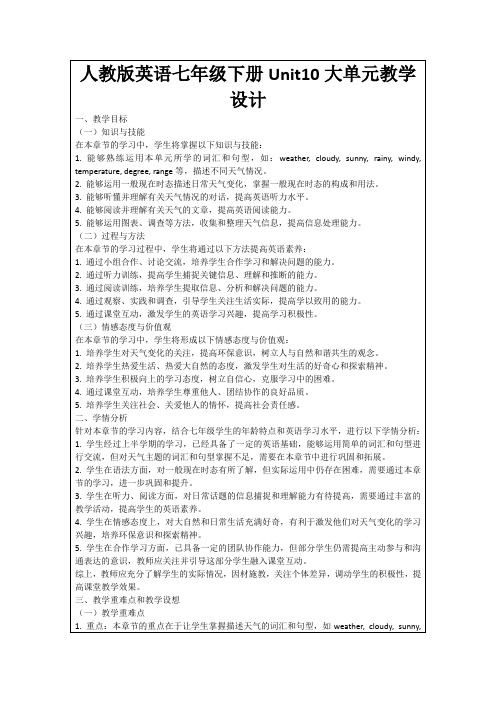
4.学生在情感态度上,对大自然和日常生活充满好奇,有利于激发他们对天气变化的学习兴趣,培养环保意识和探索精神。
5.学生在合作学习方面,已具备一定的团队协作能力,但部分学生仍需提高主动参与和沟通表达的意识,教师应关注并引导这部分学生融入课堂互动。
综上,教师应充分了解学生的实际情况,因材施教,关注个体差异,调动学生的积极性,提高课堂教学效果。
三、教学重难点和教学设想
(一)教学重难点
1.重点:本章节的重点在于让学生掌握描述天气的词汇和句型,如weather, cloudy, sunny,rainy, windy等,以及运用一般现在时态描述天气变化。
3.教师选取部分学生进行答案展示,针对共性问题进行讲解,提高学生的实际运用能力。
4.学生互相批改练习,培养合作学习意识,提高自我纠错能力。
(五)总结归纳
1.教师带领学生回顾本节课的学习内容,总结词汇、句型、语法等知识点。
2.学生分享自己在学习过程中的收获和感悟,互相鼓励,共同进步。
3.教师强调情感态度与价值观的培养,让学生认识到关注天气变化、保护环境的重要性。
2.能够运用一般现在时态描述日常天气变化,掌握一般现在时态的构成和用法。
3.能够听懂并理解有关天气情况的对话,提高英语听力水平。
4.能够阅读并理解有关天气的文章,提高英语阅读能力。
5.能够运用图表、调查等方法,收集和整理天气信息,提高信息处理能力。
(二)过程与方法
在本章节的学习过程中,学生将通过以下方法提高英语素养:
2.教师讲解一般现在时态的构成和用法,结合实际天气情况,进行示例演示,让学生在实际语境中感知语法规则。
人教版七年级英语下册第十单元同步教学设计
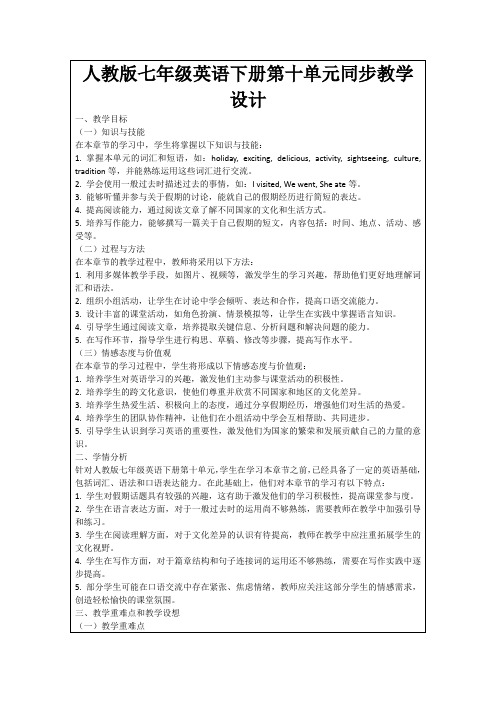
(二)讲授新知
1.教师呈现本节课的重点词汇和短语,如:holiday, exciting, delicious, activity, sightseeing, culture, tradition等,并通过例句展示它们在实际语境中的运用。
3.教师组织学生进行课堂练习,如填空、翻译、改错等,巩固词汇和语法知识。
(五)总结归纳
1.教师邀请学生回顾本节课所学内容,包括词汇、语法、阅读和写作技巧等。
2.教师引导学生总结一般过去时的用法,并提醒他们注意在实际交流中灵活运用。
3.教师强调学习英语的重要性,激发学生继续学习的动力,为下一节课的学习做好铺垫。
3.针对阅读教学,教师可以尝试以下设想:
(1)引导学生通过略读、寻读等策略,快速获取文章大意。
(2)设计问题链,引导学生深入理解文章细节,提高阅读理解能力。
(3)组织课堂讨论,让学生就文章中的文化现象进行交流,拓展文化视野。
4.针对写作教学,教师可以采用以下设想:
(1)提供写作框架和模板,指导学生进行篇章构思。
4.培养学生的团队协作精神,让他们在小组活动中学会互相帮助、共同进步。
5.引导学生认识到学习英语的重要性,激发他们为国家的繁荣和发展贡献自己的力量的意识。
二、学情分析
针对人教版七年级英语下册第十单元,学生在学习本章节之前,已经具备了一定的英语基础,包括词汇、语法和口语表达能力。在此基础上,他们对本章节的学习有以下特点:
2.教师讲解一般过去时的用法,引导学生观察并总结一般过去时的构成规律,如:动词过去式、时间状语等。
2023-2024学年人教版七年级英语下册第十单元同步教学设计
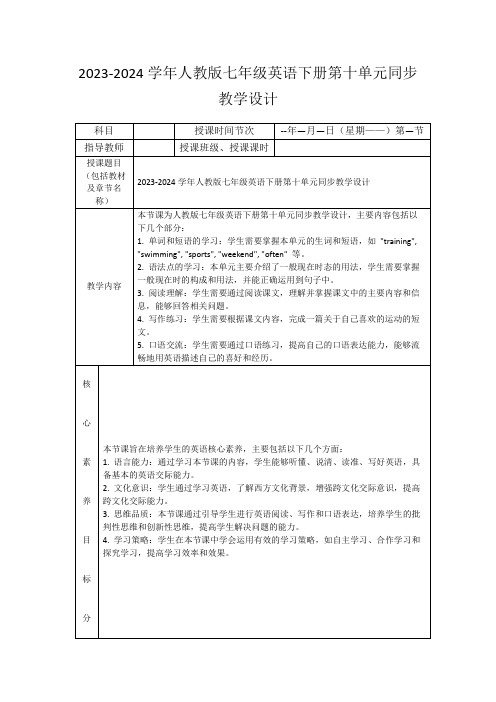
3.思维品质:本节课通过引导学生进行英语阅读、写作和口语表达,培养学生的批判性思维和创新性思维,提高学生解决问题的能力。
4.学习策略:学生在本节课中学会运用有效的学习策略,如自主学习、合作学习和探究学习,提高学习效率和效果。
6.教学工具:准备教学所需的工具,如投影仪、电脑、音响设备等,并确保其正常运行。此外,制作课件和教学PPT,以便在课堂上进行演示和讲解。
7.学生反馈表格:准备学生反馈表格,以便在课堂上收集学生的学习情况和意见。例如,设计一个简单的问卷调查表格,让学生填写他们对本节课的教学内容、教学方法和教学资源的评价和建议。
教师总结各组的亮点和不足,并提出进一步的建议和改进方向。
6.课堂小结(5分钟)
目标:回顾本节课的主要内容,强调运动的重要性和意义。
过程:
简要回顾本节课的学习内容,包括运动的基本概念、组成部分、案例分析等。
强调运动在现实生活或学习中的价值和作用,鼓励学生进一步探索和应用运动。
布置课后作业:让学生撰写一篇关于自己喜欢的运动的短文,以巩固学习效果。
其次,在基础知识讲解环节,我发现部分学生对于一般现在时态的用法还是有些混淆,所以在讲解时,我可以更加详细地举例说明,让学生们能够更好地理解和运用。同时,我也可以利用一些教学辅助工具,如PPT、示意图等,让学生们更加直观地了解一般现在时态的构成和用法。
再次,在案例分析环节,我发现学生们对于运动项目的了解还不够深入,所以在分析案例时,我可以引导学生更多地关注运动项目的背景、发展历程以及运动明星的故事,以增加学生对运动项目的了解和兴趣。同时,我也可以组织学生们进行一些小组讨论,让他们能够有机会表达自己的想法和观点,提高他们的口语表达能力。
人教英语七年级下册第10单元教案优秀教学案例
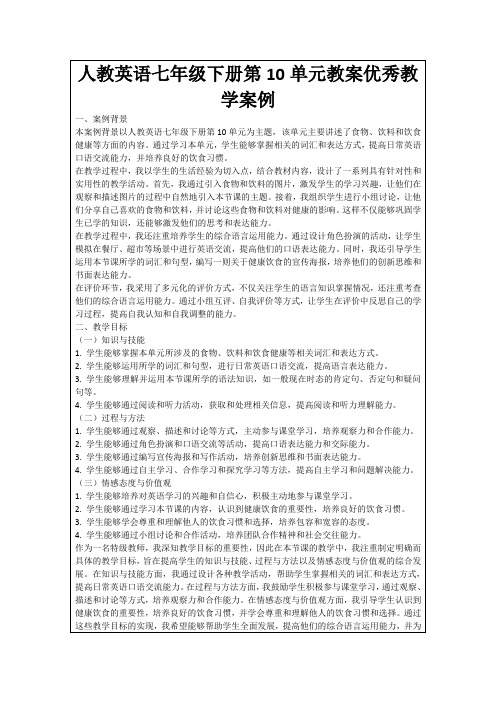
(一)导入新课
1.课堂开始时,我通过展示一些食物和饮料的图片,引发学生的兴趣和好奇心,激发他们对本节课主题的兴趣。
2.我向学生提问:“你们最喜欢的食物和饮料是什么?”让学生自由发言,分享他们的喜好,并简要介绍他们喜欢的食物和饮料的特点。
3.接着,我引导学生思考食物和饮料对健康的影响,让学生意识到健康饮食的重要性,为后续学习打下基础。
(四)反思与评价
1.教师引导学生进行自我反思,评估自己的学习效果,帮助学生发现自己的优点和不足,调整学习策略。
2.设计多元化的评价方式,如小组互评、自我评价等,让学生在评价中反思自己的学习过程,提高自我认知和自我调整能力。
3.教师根据学生的表现和反馈,及时调整教学策略和教学内容,以满足学生的学习需求。
4.鼓励学生参与评价过程,培养他们的评价能力和批判性思维。
作为一名特级教师,我深知教学策略的重要性,因此在本节课的教学中,我注重运用情景创设、问题导向、小组合作和反思与评价等教学策略。通过情景创设,我能够激发学生的学习兴趣和动机,提供丰富的语言输入,增强学生的语言感知和理解能力。通过问题导向,我能够引导学生思考和探索食物、饮料和饮食健康之间的关系,培养他们的问题解决能力和批判性思维。通过小组合作,我能够培养学生的团队合作精神和社会交往能力,提高他们的语言运用能力和思维能力。通过反思与评价,我能够帮助学生发现自己的优点和不足,调整学习策略,同时根据学生的表现和反馈,及时调整教学策略和教学内容,以满足学生的学习需求。通过这些教学策略的运用,我期望能够提高学生的综合语言运用能力,培养他们的自主学习能力和问题解决能力,并为他们的未来学习和生活打下坚实的基础。
(二)讲授新知
1.在导入新课之后,我进入本节课的主要内容,讲授食物、饮料和饮食健康相关的词汇和表达方式。
人教英语七年级下册第10单元教案教学设计

1.教师将学生分成小组,让他们用一般过去时态讨论以下话题:“Share your interesting experiences during the last summer vacation.”
2.学生在小组内轮流发言,尝试用一般过去时态描述自己的假期经历,组内其他成员认真倾听,给予评价和建议。
(二)过程与方法
1.采用情景教学法,让学生在真实的语境中学习英语,激发学生的学习兴趣。
2.运用任务型教学法,引导学生通过小组合作完成任务,培养学生的团队协作能力。
3.利用多媒体教学资源,如图片、视频等,帮助学生形象地理解和记忆单词、短语和句型。
4.创设丰富的课堂活动,如角色扮演、小组讨论、听力练习等,提高学生的英语实际运用能力。
2.教师通过讲解、举例等方式,详细解释一般过去时态的构成和用法,强调动词过去式的变化规则。
3.教师引导学生学习本节课的常用句型,如:“What did you do during your summer vacation?”、“I went to the beach with my family.”等,并让学生进行模仿练习。
5.鼓励学生进行自主学习,培养学生的自主学习能力和解决问题的能力。
(三)情感态度与价值观
1.培养学生对英语学习的兴趣和热情,提高学生的自信心,使其敢于开口说英语。
2.培养学生热爱生活,珍惜假期时光,懂得分享和关爱他人的品质。
3.增强学生的环保意识,教育学生在旅行过程中要注意保护环境,从小事做起。
4.通过学习本章节内容,使学生了解不同地域的文化差异,培养学生的跨文化交际意识。
c.写作:教师让学生编写一篇关于自己假期经历的短文,要求运用一般过去时态和本节课所学的词汇、句型。
七年级英语下册Unit 10 教学计划 人教新目标版
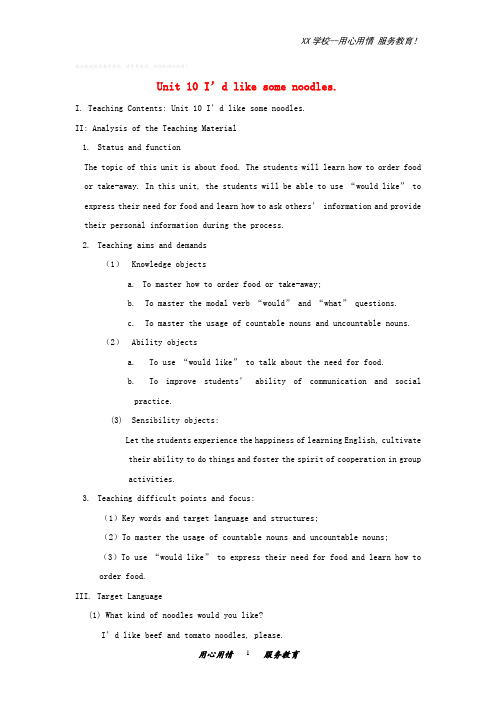
精品基础教育教学资料,请参考使用,祝你取得好成绩!Unit 10 I’d like some noodles.I. Teaching Contents: Unit 10 I’d like some noodles.II: Analysis of the Teaching Material1.Status and functionThe topic of this unit is about food. The students will learn how to order food or take-away. In this unit, the st udents will be able to use “would like” to express their need for food and learn how to ask others’ information and provide their personal information during the process.2.Teaching aims and demands(1)Knowledge objectsa.To master how to order food or take-away;b.To master the modal verb “would” and “what” questions.c.To master the usage of countable nouns and uncountable nouns.(2)Ability objectsa.To use “would like” to talk about the need for food.b.To improve students’ ability of com munication and socialpractice.(3) Sensibility objects:Let the students experience the happiness of learning English, cultivate their ability to do things and foster the spirit of cooperation in groupactivities.3.Teaching difficult points and focus:(1)Key words and target language and structures;(2)To master the usage of countable nouns and uncountable nouns;(3)To use “would like” to express their need for food and learn how toorder food.III. Target Language(1) What kind of noodles would you like?I’d like beef and tomato noodles, please.(2) What size bowl of noodles would you like?I’d like a large / medium / small bowl of noodles.(3) What is your address?My address is…IV. Vocabularylarge, noodles, beef, chicken, mutton, potatoes, cabbage, dumplings, porridge, soup, green tea, orange juice, would like, address, kind, size, bowl.V. Teaching TimeFive periodsnoodles?4)Can you find the differences among the three bowls of nood les?5)Show the sign ___Special 1, Special2, Special3 to understand their meanings.Step2. Presentation1. Teach the new words of food used in noodles.2. Look at the numbered list of ingredients. Read and repeat.3. Ask students to match each word with the foods in 1a.Step3. Grammar1.Present the countable and uncountable nouns.2.List many words, and let the students discuss in groups and tellus what kinds of nouns these words are.Step4. PresentationPresent the target language as following:A: What kind of noodles would you like?B: I’d like beef and tomato noo dles, please.Step5. Practice the drill1、Read the conversation above.2、Ask students to work in pairs. One person is the waiter, the otherone is the customer. Then let them perform the conversation in front of the classroom.Step6. Listening1、Show three bowls of noodles in picture. Ask: What ingredients arein these noodles?2、Play the recording the first time .Students only listen.3、Play the recording a second time and correct the answers. Step7. Homework1.Review the knowledge learned in this period.2.Copy the new words.The second periodI . Teaching Aims and Demands1.Knowledge objectsa)To review how to order food;b) Key structures: A: What size bowl of noodles would you like?B: I’d like a large / medium / small bowl of noodles.2. To learn the key structures in this period; A: What size bowl of noo dles would you like?To train students’ ability of listening and reading.II. Teaching Focuses1. To learn how to express their likes and dislikes;2. To do some reading practice.III. Teaching ProceduresStep1. RevisionRevise the food words and target languages in this unit.Step2. Game.Describe noodles (kind, size) in four sentences. Ask four students to stand in front of the classroom one by one, and let him or her to guess what kind of noodles and size bowl of noodles it is. Continue the competition.Step3. Presentation1.Read the numbered list of words in 1a and repeat.2.Ask students to match each word with a picture. Write the letterof each food picture in the blank in front of the correct word.Check the answers.Step4. Practice1. Circle the things they like and put an X in front of the things they don’t like.2. Learn to express their likes and dislikes as 1b. (I like… I don’tlike….)3. Work in pairs. Tell each other what they like and don’t like.Step5. Listening1. 2a: Let the students circle each of the words in 1a that they hear.2. 2b: Let th e students write down the information on the order form. Step6. PracticeWork in pairs. Student A works in the House of Dumplings. Look at the order form. Ask student B questions and fill in the order form. Individual designStep7. Reading and writin gLet the students read the words in 3a and the newspaper ad, then fill in the blanks.Step8. HomeworkThe fifth periodI.Teaching Aims and Demands1.Knowledge objects(1) To learn how to write an ad for a noodle or dumpling restaurant.(2) To do some reading and writing practice;(3) Self-checkII.Teaching FocusesTo learn how to write an ad for a noodles or dumplings restaurant IV Teaching ProceduresStep1. RevisionRevise the food words learned in last period.Step2. Survey:Let the students ask their partners and classmates: What food do you like?Step3. PracticeRead the ad in 3b. Write a word in each blank. Check the answers. Step4. WritingLook back at the ad in 3a.2. Let the students write their own ad.They can use some of the sentences from activity 3a. But please use their own types of dumplings and choose different drinks. They ca n also change the prices.Step5. Practice1. Let t he students read their partner’s ad. Notice the kinds offood and prices. Then order food from their partners.POSTSCRIPT:(课后记)。
【人教版】新目标七年级下册英语:Unit 10 教学设计

Unit 10 I’d like some noodles.Section A (1a-2d)一、教学目标:1. 语言知识目标:1) 能掌握以下单词:noodles, mutton, beef, cabbage, potato, special, would, would like, order, bowl, size, tofu能掌握以下句型:①—What would you like?②—I'm not sure yet. Are there any vegetables in the beef noodles?③May I take your order?④—Can we have two bowls of beef soup then?—Sure. What size would you like?—Medium, please.2) 能了解以下语法:情态动词would的用法;3)能掌握订餐或叫外卖等的用语.2. 情感态度价值观目标:体会学习英语的乐趣,做到“在用中学”“在学中用”.养成一个良好的饮食习惯.二、教学重难点1. 教学重点:1) 学习掌握本课时的重点词组及表达方式.2) 引导学生们做听、说的训练.2. 教学难点:通过role-play的方式掌握如何订餐等用语.三、教学过程Ⅰ. Warming-up and lead in1. Watch a video program about food and vegetables.2. Ask and answer: What's your favorite food/drink/vegetables?Ⅱ. Presentation1. (show some pictures of food on the big screen)Present some new words and expressions to the Ss.2. Ss learn the new words and expressions by themselves and try to remember them.3. Work on 1a:Read the words on the left and look at the pictures on the right. Write the letters of the food on the line. Then check the answers.Ⅲ. Game (Guess the food.)(Show some pictures of food on the big screen)Let Ss guess what food it is.Ss try to guess the food and learn the words.Ⅳ. ListeningT: In the following conversation, one man is ordering some food. Now, let’s listen to the tape, find out the right noodles the person orders.Play the recording for the Ss to listen and check the answers.Ⅴ. Pair work1.Present the conversation in 1b on the big screen and ask Ss to practice it.2. Make their own conversations using the noodles in the picture.3. Let some pairs act out their conversations.Ⅵ. Listening1. Work on 2a;T: Now, look at the pictures on the right, listen to the conversations and check the names of the foods you hear.(Play the recording for the first time, students only listen carefully.Then, listen to the recording again, and check the names of the foods.Check the answers. )2. Work on 2b:(Play the recording for the Ss to listen and complete the sentences.)Play the recording twice. The first time Ss just listen. And the second time, Ss listen and write down the words.(If necessary, use the pause button to help Ss)3. Check the answers.Ⅶ. Pair work1. Ask and answer questions with your partner. Use the information in 2a.2. Show the conversations of 2a on the big screen to the Ss.3. Make a model for the Ss.T: What kind of noodles would you like?S1: I'd like beef noodles, please.…3. Ss work in pairs and practice the conversations.Ⅷ. Role-play1. Ask Ss to read the conversation in 2d and find the answer to this question:What would they like?(They would like one large bowl of beef soup, one gongbao chicken, and one mapo tofu with rice.)2. Check the answers with the Ss.3. Ss work with their partners and role-play the conversation.VIII. Language pointsIX. ExercisesHomework1. Review the words and expressions in this period.2. Role-play the conversation in 2d.3. Write a short conversation to order some noodles you like in a restaurant.板书设计:Section A (Grammar Focus-3c)一、教学目标:1. 语言知识目标:1) 继续练习运用如何订餐或叫外卖等的用语.2) 根据所提供的材料能运用所学的知识来补全对话.3) 总结复习订餐时所用句型结构.2. 情感态度价值观目标:体会学习英语的乐趣,做到“在用中学”“,在学中用”.养成一个良好的饮食习惯.二、教学重难点1. 教学重点:1) 总结订餐所用语言及句子结构.2) 学习理解情态动词would的用法.3) 通用所学的知识在实际情境中订餐.2. 教学难点:1) 在较为真实的订餐语境中会运用学过的语言知识来补全对话.2) 能掌握订餐的用法,并在实际情境中运用.三、教学过程Ⅰ. Grammar Focus.1. 学生阅读Grammar Focus中的句子,然后做填空练习.①你想要什么面条?______________________________________请给我来牛肉面.________________________②你想要什么碗的?_______________________请给我来中碗的. ________________________________③你想来一个大碗吗? ____________________________________好的.______________________④在西红柿鸡蛋汤里有肉吗? _______________________________不,没有._______________________⑥I’d = ____________⑦She’d = _________⑧不可数名词有:bread, milk, water, _____________________________⑨既是可数又是不可数的名词:salad, chicken, ice cream, ______________2. Ss finish off the sentences and check the answers by themselves.3. 自主探究II. 探究乐园一、would like意为“想要某物”,常用句式结构:1. 你想要点什么?What ______ you ______?我想要一杯茶.____ _____ a cup of tea.你想要什么面条?What ____ of noodles _____ you like?你想要多大号的毛衣?What ____ of sweater ______ you like?(以上句型为有礼貌、委婉地表达征求对方的要求)2.Wo uld you like …? 你想要……吗?这也是用来向对方有礼貌地语气委婉地征求对方要求的句型.其答语为:Yes, please. /OK. /No, thanks.你想要一些牛奶吗?______ you _____ some milk?是的,谢谢./ 不,谢谢.Yes, _______. / No, _______.【拓展】Would you like to do sth.? 你愿意做某事吗?用来有礼貌地向对方提出建议或邀请的句型.答语常为“Yes, I’d like to.”“Sorry, …”二、可数名词与不可数名词1. 可数名词:可数名词有单数、复数之分.其复数形式一般要加-s或-es.如:potato—_______; tomato—__________2. 不可数名词没有复数形式,只有单数形式.如:some ______ (米饭);a lot of _____ (牛肉)(1) 不可数名词表示数量的多少时,必须与表示数量的名词连用,即“数词+表示数量的名词(可数名词)+ of + 不可数名词”,如:两玻璃杯果汁三碗米饭_____ ______ of juice _____ ______ of rice(2) 不可数名词做主语时,谓语动词只能用单数形式.例如:在碗里有一些羊肉汤.There _____ _____ mutton soup in the bowl.【拓展】如果不可数名词前有复数名词短语修饰时,谓语动词须用复数形式.如:房间里有两袋子大米.______ ______two bags of rice in the room.Ⅲ. Practice1. Work on 3a. Tell Ss to complete the conversation with sentences on the right.2. Ss work by themselves and complete the conversation.3. Check the answers with the Ss.4. Let Ss practice the conversations in pairs.Ⅳ. Practice1. Work on 3b.Tell Ss to write questions and answers using the words in the brackets.Give a model to the Ss.What kind of noodles would you like?2. 指导:看提示词,确定句子是对什么事情提问,检查句子的语序是否正确.最后,再根据自己的实际情况回答些问题.3. Practice the conversation with your partners.Ⅴ. Survey1. Look at the pictures. There are four kinds of special foods.Who would like them, please make survey of you classmates.2. Give Ss a model:S1: Anna, What would you like?S2: I'd like beef noodles with cabbage.…3. Write the result on a piece of paper and write a report.4. Read your report in your group.Ⅵ. ExerciseHomework1. Remember the sentences in Grammar Focus.2. Make some conversations to ask your friends what food they would like. Write ashort conversation.板书设计Section B (1a-2c)一、教学目标:1. 语言知识目标:1) 能掌握以下单词:world, answer, different, cake, candle, age, blow, blow out, if,will, UK, candy, lucky, popular, cut up idea2) 能掌握以下句型:①The answer would be different in different countries.②The number of candles is the person's age.③In China, it's getting popular2. 情感态度价值观目标:体会学习英语的乐趣,做到“在用中学”“在学中用”.了解世界各地的饮食文化,生日文化等事情,使学生们具有初步的世界文化观念.二、教学重难点1. 教学重点:1) 通过进行听、说的训练,来提高学生们综合运用所学知识的能力.2) 通过读、写的训练,来让学生们能真正在实际活动中运用所学的知识.2. 教学难点听力训练与阅读训练三、教学过程Ⅰ. Warming- upLet’s watch a video and learn.Ⅱ. Presentation1. (show some pictures of food on the big screen)Present some new words and expressions to the Ss.2. Ss learn the new words and expressions by themselves and try to remember them.3. Work on 1a:Read the words in the chart and look at the pictures below. Write the letters of the foods or drinks on the line. Then check the answers.4. Let Ss try to remember the new words and expressions.Ⅲ. Pairwork1. Circle the things you like in 1a. Put an х next to the things you don’t like Then tellyou partner what you like and don't like.Sa: I like dumplings, but I don't like noodles.Sb: Well, I like fish but I don't like meat.2. Work in groups. Talk about what you like and what you don’t like.3. Make a list of things every one likes and dislikes in your group. Then give areport to your classmates:In our group, Sa likes dumplings but she doesn't like noodles. Sb likes fish but she doesn't like meat. …4. Let some Ss give their report.Ⅳ. ListeningWork on 1c:1. Ask Ss to read the ORDER FORM carefully.2. Play the tape for the Ss to listen and complete the food order form.(Play the recording for the first time, students only listen carefully.Then, listen to the recording again, and write down the names of the foods. )Work on 1d:Listen again. Use the pause button to check the answers with the Ss.Ⅴ. Group work1. Work in groups. Discuss what do you do or eat on your birthday?2. Ss take turns to talk about it.S1: I usually get many nice gifts from my parents. I usually have a nice dinner ina restaurant.S2: My parents usually buy me some nice books and school things on my birthday.S3: ….3. Write down what your group members do on their birthday. And give a report tothe class.In my group, S1… S2… S3…Ⅵ. Presentation1. (show some pictures of the new words in the passage on the big screen)Present some new words and expressions to the Ss.2. Ss learn the new words and expressions by themselves and try to remember them. Ⅶ. Reading1. Fast readingTrue or False2. Careful readingRead the passage complete the chart below.阅读指导:首先,读表格,记住这四空格,分别是在美国及中国人们在过生日时所吃的食物及他们的特殊含义.其次,带着问题去仔细读短文,并在短文中寻找相关问题的回答依据.然后,根据相关依据,将答案写在空格处.3. Read the messages again. Find the answers to the questions in 2c.阅读指导:首先,读这四个问题,记住这四个问题.其次,带着问题去仔细读短文,并在短文中寻找相关问题的回答依据.然后,根据相关依据,写出问题的答案.Check the answers with the Ss.VIII. Language pointsIX. ExerciseHomework1. Remember the new words and expressions in this period.2. 用下列词汇造句:1) around the world2) in different countries3) the number of 4) blow out5) in one go 6) come true7) get popular 8) cut up板书设计:Section B (3a-Self Check)一、教学目标:1. 语言知识目标:1) 继续练习运用如何订餐或叫外卖等的用语.2) 根据所提供的材料能运用所学的知识来补全对话.3) 总结复习订餐时所用句型结构.2. 情感态度价值观目标:体会学习英语的乐趣,做到“在用中学”“在学中用”.了解世界各地的饮食文化,生日文化等事情,使学生们具有初步的世界文化观念.二、教学重难点1. 教学重点:1) 通过进行听、说的训练,来提高学生们综合运用所学知识的能力.2) 通过读、写的训练,来让学生们能真正在实际活动中运用所学的知识. 2. 教学难点阅读训练与写作训练三、教学过程Ⅰ. Warming- up and revision1. Check the homework and have a dictation of the new words and expressions.2. Let some Ss retell the passage in 2b.Ⅱ. Writing1. Read the ads in 3a. Fill in the blanks with the words in the box.阅读指导:首先,明白方框里单词的意思;其次,阅读这个小广告,了解其大意;然后,认真读每一个句子,根据上下文及空格前后的关键词来确定空格处的意思.并确定应用哪个单词填空.最后,再通读一遍广告内容,看短文是否通顺恰当.2. 学生们按老师所指导的方法,认真阅读短文,并用正确的单词填空.3. Check the answers.III. Writing1. Make sure the Ss know what to do.(Imagine you have a special restaurant, write the foods and prices.)2. Ss work by themselves and try to write the foods and prices.3. 指导:可先列出食物名称,然后,再写出价格.最后,再用英语写出来.e.g. burgers: 3$ soup: 1$We have nice burgers for three dollars. The soup is only one dollar.4. Let some Ss read out their sentences.IV. Writing1. Write an ad for you restaurant. These sentences structures may help you.2. Let Ss read the sentences first, and try to remember them.3. Let Ss make a list of the food and drinks in your restaurant.4. Use the sentences structures and write the ad.5. Let some Ss read out their ad. Show some good ad on the big screen as a model. V. Self Check 11. Make sure Ss know what to do.Put the words you learned in different groups.2. Check the answers.VI. Self Check 21. Tell Ss they'll read some interesting jokes. Read the jokes below and fill in theblanks with "there be" structure.2. 指导:这里是考查there be句型中的主谓一致原则及近主语原则的知识.3. Ss read the jokes and fill in the blanks.4. Check the answers with the Ss.5. Let Ss act out the joke for fun.Ⅷ. Making a conversation1. If you are in a restaurant. What should the waiter say to you?What should yousay to the waiter to order? Now look at the clues below and write a conversation.2. Ss read the clues and try to write a conversation.3. Check the answers with the Ss.VIII.PracticeHomework1. Review the new words and phrases of this unit.2. Write a short ad for your uncle's noodle restaurant.板书设计。
- 1、下载文档前请自行甄别文档内容的完整性,平台不提供额外的编辑、内容补充、找答案等附加服务。
- 2、"仅部分预览"的文档,不可在线预览部分如存在完整性等问题,可反馈申请退款(可完整预览的文档不适用该条件!)。
- 3、如文档侵犯您的权益,请联系客服反馈,我们会尽快为您处理(人工客服工作时间:9:00-18:30)。
Unit10 I’d like some noodles .
单元教学设计
汪成涛
一、教学内容分析及整合思路
本单元是七年级英语Go for it ( 下) Unit10。
主要围绕“Order food and write food ad”这一主题展开各种教学活动.学生必须学会订餐并提供个人信息。
本单元首先介绍一些食物的名词,例如:面条、牛肉、鸡肉、羊肉、洋白菜、洋葱、土豆和西红柿。
与此同时教学本单元的重点what引导的特殊疑问句和情态动词would的用法。
Section A部分首先让学生学习一些食物类名词的表达方法,明确这些名词哪些是可数的,那些是不可数的,进而延伸并使学生掌握对面条种类的表达;与此同时借助于情景的创设,使学生学会what size...的运用和对此句的回答。
在以上学习的基础上,学生进行简单的供餐与订餐的对话,也能听懂简单的听力材料。
Section B部分要求学生能够做调查并汇报,还能写简单的广告。
基于以上对教材的分析,本单元所学习的内容与学生的日常生活密切相关。
语言材料的可操练性比较强,如学生在谈论自己所喜爱的食物时能够畅所欲言。
教材内容将语言知识和交际训练有效地融为一体,通过从新词教学到语句教学再到片段的教学,循序渐进逐步展开,使学生学会在情景中灵活运用所学语言准确表达个人的信息,从而提高学生的听、说、读、写能力。
体现语言的交际性和工具性;在学习过程中,渗透健康饮食的重要性,同时引导学生养成平衡膳食正确消费的习惯。
体现英语教学的社会性。
本单元反复操练的句型是what would you like what kind of 、、、would you like what size 、、、would you like 让学生在学习的过程中,熟练掌握本单元的主要内容。
二、学习者特征分析
1、学生现有的能力与已掌握的知识:学生在经过了一学期的学习后已经具备了一定的听说读写基础,如在七年级上册已经学习了部分水果类名词和食物类名词,还学习了what 引导的特殊问句,为谈论本单元话题垫定了一定的基础,但学生在谈论事物的种类时,容易把起限定作用的名词误用成复数。
2、本单元主要是谈论饮食的话题,和学生的日常生活密切相关容易引起学生的兴趣,学生参与起来也比较积极。
加上声行并茂的听觉和视觉刺激,特别是扮演服务员和顾客,然后进行对话学生更加投入,这为本单元的学习打下了良好的基础。
三、单元整体目标分析
$
1、知识与能力:
(1)熟练掌握本单元的重点短语:size, Bowl, kind of, cabbage, tomato, green tea, potato,
beef, mutton等。
(2)能掌握并熟练运用情态动词would;
(3)能正确运用“What kind of …would …like和What size bowl of …”句型;
(4)通过本单元的学习,能够运用目标语言进行简单的订餐和供餐间的对话,能写出简单的广告。
2.过程与方法
(1)通过Pairwork ,进行供餐与订餐的对话交流;在对话交流中,培养学生与人沟通的能力;
(2)充分利用录音材料进行听说模仿训练,以及情景对话训练等方式提高学生运用语言的能力;
3、情感态度与价值观:
引导学生养成正确健康的饮食习惯和消费习惯。
…
四、重点、难点
1.教学重点
(1)重点词汇:noodle、beef、cabbage、potato、special、drink、juice、dumping、porridge、tea、rice、soup、fish、green tea、onion、menu、、、、
(2)重点句型:What would you like I would like 、、、、
What kind of noodles would you like what size bowl of noodles would you like (3)话题:围绕“order food ”展开讨论。
语法焦点在于情态动词would和what 引导的特殊问句的用法。
2.教学难点
(1)能够运用所学知识叫餐并提供个人信息;
(2)熟练掌握对食物种类的描述其名词用单数。
!
五、教法选择与学法指导
根据《英语课标》和本单元教材内容,采用任务型语言教学途径,将教学目标设计成符合学生生活学习实际的任务链,尽量使学生在参与任务的过程中学习运用语言,形成语言能力,并使用多媒体辅助教学手段为学生学习营造较好的语言学习环境,提高学生学习语言的积极性。
通过任务型的教学途径,发展学生的综合语言运用能力,使语言学习的过程成为学生形成积极的情感态度、主动思维和大胆实践、形成自主学习能力的过程。
同时在教学中采用多媒体辅助教学、任务型教学模式,运用听说读写法,并以循序渐进的方式来进行教学。
$ @
Unit10 I’d like some noodles.单元教学反思:
词汇教学是英语学习的重要任务,也是英语课堂教学的重要内容。
对于初学者是靠死记硬背来学习词汇的。
而目前初中英语课本词汇大量增加,大大增加了学生的记忆负担。
因此,目前初中生学习英语时,普遍感到英语单词学习是第一难关。
单词记不住,写不出
来,直接影响着他们学习英语的兴趣和积极性,甚至直接影响他们英语学习的成败。
要帮助学生在初中阶段进一步打好学习英语的基础,我们面临的重要问题就是如何帮助学生学习好各单元的大量词汇。
七年级英语教学总的来说是单词与句型的教学。
只要学生能正确地读准英语单词,并且能背会英语单词及汉语意思,再根据所学句型进行单词替换练习,就能达到教学目标,所以七年级英语教学的关键是单词教学。
在词汇教学中,首先要教学好单词的发音和拼写,学生会读会拼,才能为继续学习单词的其他方面奠定基础。
在教学中,教师必须确保准确地、清晰地、缓慢地呈现这些单词的发音和拼写,这样学生才能准确地学习单词的发音和拼写。
在呈现词汇时,利用图示法,尽量用多媒体课件中的图片呈现一些单词,如本课学习的词汇水果、蔬菜、肉类、饮料等等,也可以适当拓展一些学生感兴趣的相关词汇。
把学习者从简单机械重复、死记硬背的枷锁里解脱出来,增加词汇学习的趣味性,增强学习信心,提高词汇学习效率。
在教学这些词汇的读音时,也使学生在形象记忆中记住这些词汇的汉语意思,同时也把培养学生的自主学习的能力渗透在词汇教学中。
其次,对单词进行分类、归纳学习。
如本课学习食品类的词汇,包括水果、蔬菜、肉类、食品、饮料等等,同时又有可数名词和不可数名词之分。
通过图片展示各种水果、蔬菜、肉类、食品、饮料等让学生进行归纳分类,学生很快就能对这些食品进行分类。
可数名词有水果、蔬菜、部分食品,不可数名词有肉类、部分食品、饮料等。
一目了然,学生看的清楚,记的牢固,自然对单词记忆产生了浓厚兴趣,同时也培养了学生观察、记忆、思维、想象、创造和自主学习的能力。
再次,通过句型替代词汇练习进行记忆词汇,提高词汇的复现率。
如本课学习运用句型What would you like I’d like some noodles. 通过学习运用这种句型使学生既记忆了词汇也学习了句型。
学生在操练句型时,可以把他们分成小组。
通过小组进行练习句型,并且给表现出色的小组加分,或是画小红花,小红旗等。
促进小组的合作意思,增强小组的集体意识,培养学生的小组合作能力和学习探究的能力。
